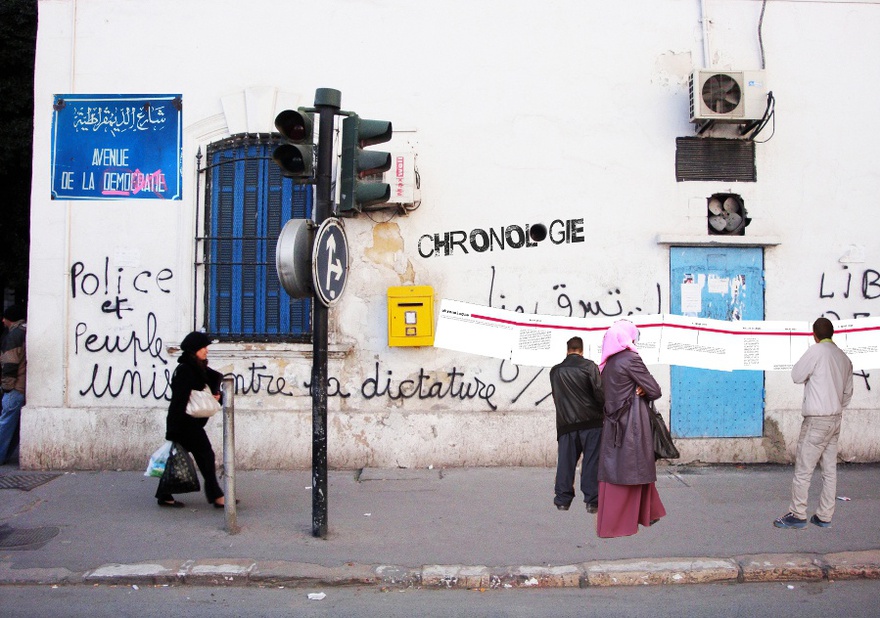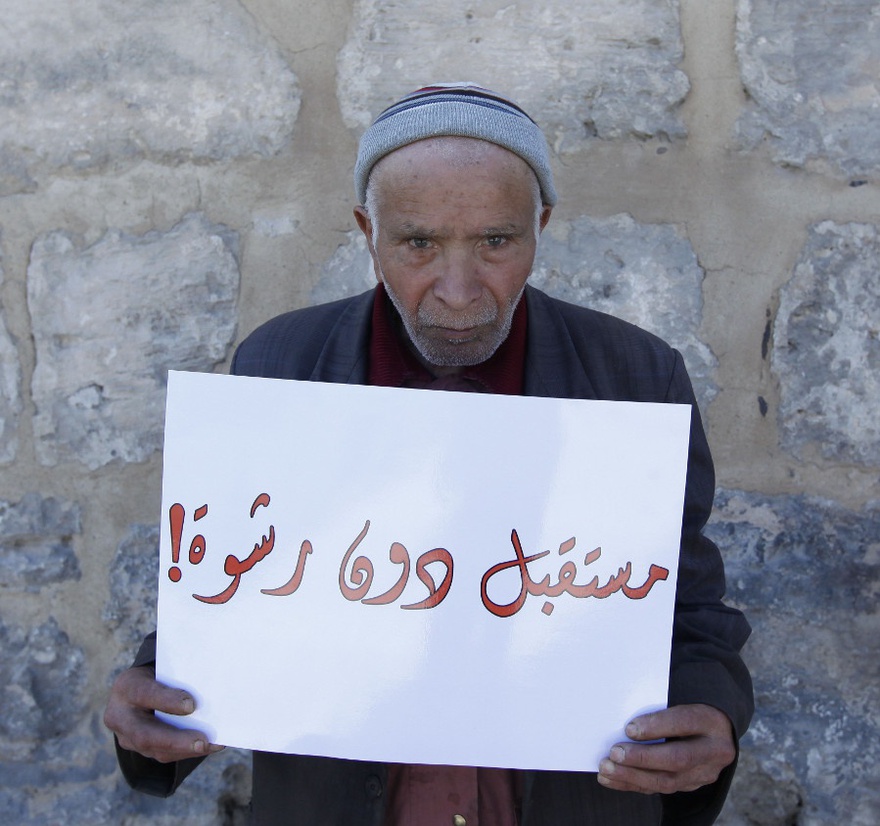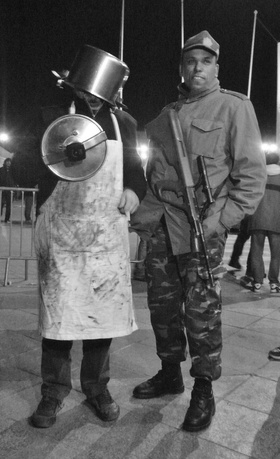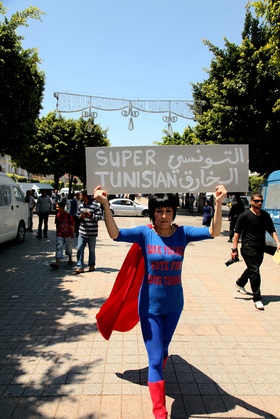Essays
The Turn المنعرج
Socially Engaged Art Practices in Tunisia
For many artists, the spirit of the revolution and the euphoria of newly won freedom have awoken an urge to participate in the formation of a modern constitutional state and an unprecedented feeling of responsibility for society and the future of one's own country. In the last five years, the activities of artists, cultural associations and scientists, curators, journalists, bloggers, and trade unions have demonstrated substantial personal engagement in the transformation processes taking place. An immense mobilization has occurred, which has crystallized in a wide range of aesthetic formations.
Encouragement and support have also come from international institutions and organizations that recognized art's potential to embed democratic ideas in the minds of the population. They have provided engaged creative workers with the pertinent training and financial means to realize their ideas. 'The arts, culture, and education play decisive roles in the constitution of societies and in coping with current global and regional challenges. Artists, persons in the cultural sector, and media players are seismographs as well as shapers of social change', states the Goethe Institute's website, for example, which offers a training programme to strengthen the cultural infrastructure and cultural sector in transition countries under the motto 'Culture and Development'.[1]
On the occasion of the presentation of the workshop 'Outreach – The City as a Museum', which took place in Tunis in 2013, Michael Spindelegger, in his role as Austrian Minister of Foreign Affairs, formulated it as follows: 'In cultural encounters resides a notable degree of conflict and problem-solving capacity, which can be accessed through the involvement of the creative potential of both the cultural workers as well as civil society.'[2]
Tunisian artists and other cultural players have gradually learned to be a mouthpiece for society. They observe the developments in the new state and protest against human rights violations. Today, there are close binds between art and sociopolitical engagement.[3] 'The political aspect in this engagement cannot be separated from artistic engagement. Art thus becomes a state affair', writes the artist and art critic Selima Karoui in her article that investigates the place of art in the public space of Tunisia.[4]
It is a necessity that this artistic activism leaves the protected space of the studio and conventional exhibition venues and to invest in new sites and places for art. Now more than ever, art requires public attention in order to be effective. For the first time the artists dare to address former taboo subjects like violations of human rights, social inequality and corruption and wish to create highest possible awareness within the Tunisian population but also in the international public eye.[5]
In this context, public space – be it in its virtual (social media) or physical-material state (streets, public places and so on) – comes to the fore. Public spaces are the new venues or action spaces for contemporary art practices. In this respect, not only urban but also more and more rural areas play an important role.[6] Public space in its understanding as an agora – a freely accessible gathering place, a place of encounters between people from different social groups, or even as a site for 'subaltern counterpublics'[7] – didn't exist in Tunisia in the recent past; first it had to be reclaimed by the population as their right to a 'common good'.[8]
This space was monopolized by the former heads of state, an appropriation that was doubly present given the pronounced personality cults. The first president of the Tunisian Republic Habib Bourguiba (1957–1987) had imposing depictions of himself set up in public space. One example is the equestrian statue that his successor, Zine El Abidine Ben Ali, banished from the city centre and sent to the harbour village La Goulette in 1987 at the beginning of his rule, in order to make space for an obelisk-shaped clock tower.[9] Instead of erecting glorious statues, he was content with 'subtle' gestures such as renaming important streets and squares[10] and with the omnipresence of his imposing, never-ageing likeness on billboards and façades.[11]
Nevertheless, the idea of public space as a site for artistic presentations is indeed rooted in the history of the Maghreb region. Just think of the public storytellers who brought their stories to the people with theatrical techniques, or the Boussadias[12] (dancers and street musicians who were ascribed magical powers and have their origins in sub-Saharan Africa), or the ancient Karakouz tradition, a satirical shadow puppet theatre that can be traced back to fourteenth-century Tunisia. Regrettably, these practices were increasingly subsumed as inferior folkloric traditions and denounced by ministers and beys, who were often the subject of the performance.[13] Street artists descended to the lowest fringe of society until they ultimately disappeared from the street altogether.[14] Previous political leaders also invested all efforts into preventing gatherings in public spaces in order to keep critical activities that endangered the system at bay.
While the above mentioned examples of traditional art in the public sphere largely catered to the entertainment and pastime of the people as a substitute for TV, radio, and social media, the present art practices in public spaces are different in one very decisive point: they invite the audience to participate. The people became the focus of the artistic work; the audiences are preferably included in the creative process and directly involved in the production of the art. Art aims to instigate self-accountability among a population who, from now on, will take their future into their own hands.[15] It subverts the longstanding status of the passive observer conditioned by the dictatorship and turns people into co-authors of a new democratic form of society. 'Instead of the work as an object we find open events, installations, actions, processes, plays, instructions for action, concepts, environments. Passive observers have become co-creators, co-players, participants', writes artist-curator Peter Weibel.[16]
In cooperation with people, cultural workers attempt to elaborate concepts for reconciling conflicts and build models for a better future. There are often longer phases of research conducted by the artists beforehand, which include, above all, acts of approaching one another, listening to each other, and sometimes also living together for a certain period of time.[17] This new form of artistic expression strives to unite all citizens and grant them the same rights. Participative art aims to restore a sense of community, stimulate dialogue in the population, and to initiate shared social engagement. These artists act as mediators between groups that otherwise wouldn't come into contact with one another. Art serves as a means to create new interpersonal relationships.[18]
In the few last years, diverse independent structures for the production of contemporary art have emerged in Tunisia. Where the state neglects, artists take the initiative and form collectives, found art associations, open new exhibition and action spaces, and organize engaged art projects, for which they invite artists from abroad to participate in as well.[19] The borders between the notions of artist, curator, project manager, neighbourhood worker, art critic, cultural politician, recipient, and so on, are fluid. This enables the realization of many notable interventions, in the urban as well as rural space of Tunisia, in the first place. Behind every project there are confident individualists who fight for the creative revolution of society with great personal commitment.
But can these new forms of artistic expression successfully embed themselves in the Tunisian cultural landscape or were/are they merely temporary phenomena triggered by the enthusiasm of the revolution and ideological and financial support from abroad? Can we see the first symptoms of fatigue, now after five years when international attention is slowly being redirected to other parts of the world and, therewith, the funding sources are running dry? Have the many obstacles – those put in the way by the state and a very conservative segment of the population – discouraged artists and cultural workers?[20] Are they frightened by the new, invisibly imposed or not yet assessable censorship by the state and society? Or is it the lack of understanding for these artistic practices – not only amongst the population but also in the elite local art circle, where key figures cling to traditional definitions of art informed by aesthetics?[21]
On an international scale, 'engaged art' is increasingly embedding itself as a sociopolitical strategy. It is an integral component in new urban planning projects or, for example, is called upon in neighbourhoods with a high level of criminality to mediate and reconcile conflicts. Departments to support 'art in public space' are being set up in ministries, and programmes are being introduced at the academies of arts, which are explicitly dedicated to the subject of art and society.
In post-'Arab Spring' societies, too, engaged artistic practices need a lobby; a strong union behind them. They require long-term investments in culture and society, which is why public appreciation, safety, and state funding are highly important in this regard. They need the recognition of their social relevance and the official acknowledgement that evolution involves – besides technological and scientific achievements - the creative potential of art.
[1] Andreas Ströhl and Enzio Wetzel, 'About the Initiative: Culture and Development', Goethe Institut website, http://www.goethe.de/ges/prj/ken/uun/enindex.htm.
[2] Michael Spindelegger, public address, 4 October 2013, Vienna, Austrian Federal Ministry website, http://www.bmeia.gv.at/das-ministerium/presse/aussendungen/2013/die-stadt-als-museum-der-oeffentliche-raum-im-kulturpolitischen-diskurs-der-laender-des-arabischen-fruehlings.
[3] Tunisian graffiti group Zwewla wrote in Arabic 'Al-shaab yurid hak ezaweli' (The people want more rights for the disadvantaged) and 'Zaweli fi Tounis meyett hay' (The disadvantaged are a living dead in Tunisia) on a university wall in the city of Gabes in November 2011. Kafon, a Tunisian rap artist, became famous, in particular, for his song Houmani, which describes the miserable life of inhabitants of a marginalized neighbourhood in Tunis. Later, Zwewla and Kafon were arrested by the Tunisian police.
[4] Selima Karoui, 'La place de l'art dans l'espace public tunisien (2),' Naawat, 18 March 2014, https://nawaat.org/portail/2014/03/18/la-place-de-lart-dans-lespace-public-tunisien-2/.
[5] It is with this aim that Faten Rouissi conceived the art project Bye Bye Bakchich Systeme (2014).
[6] Efforts have been made to also bring art to the people in regions outside the capital. Good examples of this are the projects Laaroussa (2011) where Selma and Sofiane Ouissi worked with Berber pottery women in Sejnane, a small town in an impoverished region in northern Tunisia or De Colline en Colline (2012), an interdisciplinary art project conceived by Faten Rouissi that addressed the harsh life on ancient hill side villages in the interior of the country.
[7] Nancy Fraser, 'Rethinking the Public Sphere: A Contribution to the Critique of Actually Existing Democracy,' Social Text 25/26 (1990): pp. 56-80.
[8] The people's reclamation of public space started with the demonstrations that followed the self-immolation of Mohamed Bouazizi. The persistent sit-ins on Kasbah Square and in Bardo in front of the government buildings once again demonstrate people occupying public space. Street-artists marked their newly gained territory with graffiti and tags with political messages.
[9] Despite the president's endeavour, the statue was recently returned to its place of origin in the city centre of Tunis. Beji Caid Essebsi sees this act as symbol for the re-animation of the heritage of the father of modern Tunisia.
[10] Selima Karoui, 'Art et politique en Tunisie de 1957 à 2012' in Rosige Zukunft (Berlin: Kerberverlag, 2012), p. 207.
[11] Right after Ben Ali's escape, the people's first act was to wipe out the dictator's public presence by demolishing his billboards and by painting over purple bridge railings.
[12] Sellami Hosni, 'La danse en Tunisie', in Les danses dans le monde arabe ou l'héritage des almées (Paris: L'Harmattan, 1996), pp. 145-148.
[13] Alexis Trouvé, Au desert (Moulins: Crépin-Leblond, 1898), pp. 41-42.
[14] Claudine Dussollier, 'La rue, espace public/espace politique dans le monde arabe: du Maroc au Moyen Orient,' ZAT 4(2012): pp. 23-26.
[15] Excellent examples for self-empowerment through art are Super Tunisian, or Moufida Fedhila, who passes her 'super powers' on to pedestrians and, together with them, composed the first draft of the new constitution for Tunisia. In their utopian video for the art project De Colline en Colline – Art et Citoyen (2012), Johanna and Helmut Kandl present a flash back of the success story of the formerly poor desert village Chenini. Two years later the Kandls met Sarah Toumi who's innovative plantation project Acacias for All brought hope and work to the local population.
[16] Peter Weibel, 'Artivism in the 21st Century,' in Performing Public Art (Vienna: De Gruyter, 2015), p. 58.
[17] In particular, we are thinking here of the project Laaroussa again. The initiators Selma and Sofiane Ouissi, together with other visual artists like Sonia Kallel and Tobi Ayedadjou, stayed on several occasions for a number of days over a five month-period with the Berber women from Sejnane to share their daily life. Huda Lutfi, an Egypt artist who took part in De Colline en Colline, also spent some time living in a village called Takrouna and worked with inhabitants to write down their life stories on little flags.
[18] Exemplary of artistic activism fighting against the dispersion of society is also Mouna Jemal Siala's project Non à la division, which was documented in book form in 2014 by Sa'Al Editions.
[19] In this context we would like to name Selma and Sofiane Ouissi's collective L'Art Rue in particular, who conducted pioneering work in the realm of art in public space (or public art) in Tunisia with Dream City 2007; B'chira Triki, founder of the B'chira Art Center; Faten Rouissi, founder of the association 24h pour l'art contemporain; Wassim Ghozlani and Olfa Feki, founders of the Maison de l'Image; Mohamed Hédi Belkhir, co-founder of the association Open Art Tunisia; Bahri Ben Yahmed, co-founder of the association Art Solution; the artist collective Politiques; and the artist Sana Tamzini, who soon after the revolution was nominated as the director of the Centre National d'Art Vivant (CNAV) du Belvédère and is today head of the Department for Visual Arts of the Ministry of Culture and Heritage Preservation.
[20] The artwork chronologie by the authors of this essay informs people about the on-going harassment within the country aimed against artists from all disciplines and demonstrates cases of the government's disregard for human rights. It is a matter-of-fact presentation, using the exact wording of official press releases.
[21] This lack of understanding is also a by-product of the fact that these interventions in the public space are the first encounter with contemporary art for many Tunisian citizens. To this day there is no museum for modern and contemporary art in Tunisia. In this context we point to Halim Karabibene's project about the MNAMC (Musée National d'Art Moderne et Contemporain) – a non-existent museum – represented in the form of a pressure cooking pot.









